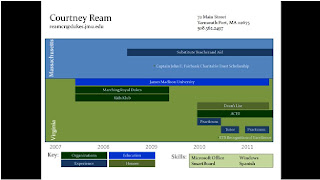In the beginning of the semester, we learned a little bit about how to create a visual resume. I recently found an article from Mashable,
9 Dynamic Digital Resumes, that gives four great tips for creating a visual resume:
1. Give the reader your history
2. Aesthetics matter
3. Make it personal
4. Use graphics to inform
Do you agree with these principles? Did you use them in your visual resume?
Mashable also posted
an article about creating impressive video resumes. It states that in order for a video resume to be successful, you should use the following guidelines:
1. Make sure it's appropriate
2. Don't just read out your resume
3. Keep it short
4. Don't be afraid to be creative
5. Make sure it passes the share test
The article also provides some great examples of video resumes. Have you ever created a video resume? What principles from our Visual Literacy class do you think apply to video resumes?


























